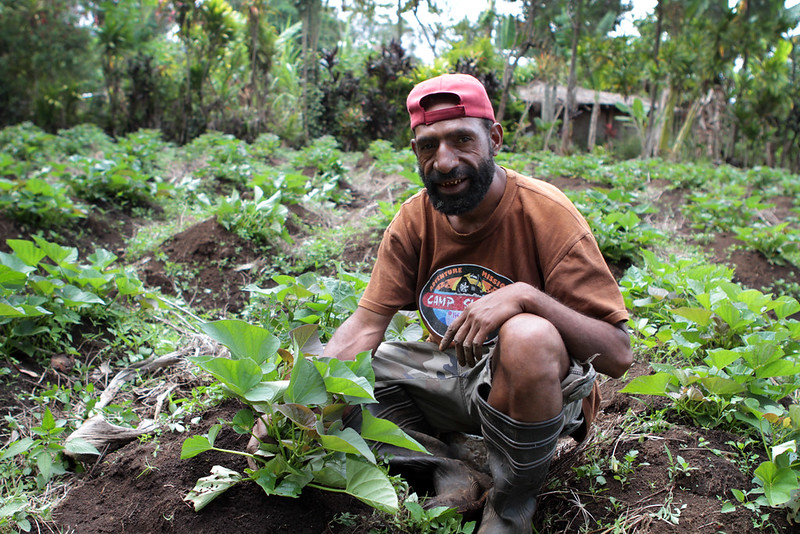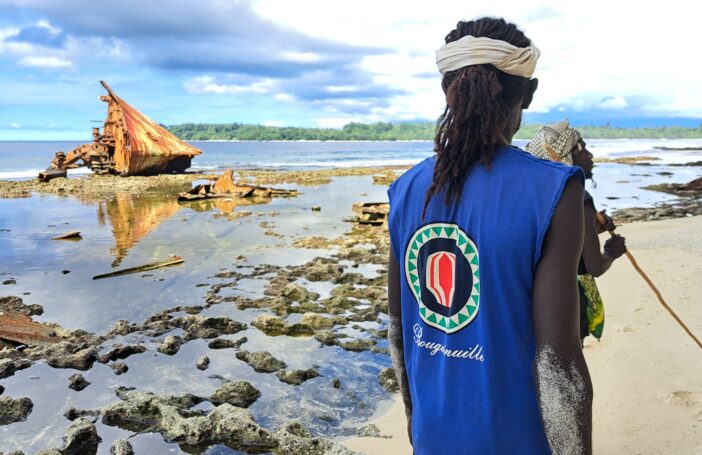When my late colleague Tom Betitis and I were surveying village agriculture on Bougainville Island, we stopped in Igau Village in the Kieta area. As we walked with villagers to the garden area, I noticed a few chili plants and asked the landowner whether his family grew them for sale. He responded:
Bifo mipela i salim sampela sili. Tasol mipela i les long sili. Emi bikpela wok na mipela i kisim liklik mani.
Previously we sold some chilies. However, we grew tired of growing chili for sale as this required a lot of work for a small cash return.
“Bikpela wok na liklik mani” – “big work but small money”. Comments by villagers on how much income they earn from growing and selling a certain crop compared with how much work this entails are common in Papua New Guinea, and indeed elsewhere in Melanesia.
The cash income from agricultural enterprises compared with the labour inputs is an important consideration when people decide what to grow for sale. The technical term is “cash returns per labour input”. Villagers do not use such a term, but their decisions are based on such an analysis.
In a recent policy brief, I have calculated the rate of return on each day’s labour input for 26 actual or potential cash crops in PNG. The output of that analysis is the return (in kina) per person-day labour input to grow, process and sell that commodity. The analysis is based on the best available estimates of crop yield, price received by growers (after marketing costs), cash outlays and labour inputs.
My analysis shows that, at current prices, the greatest returns on labour input came from vanilla, kava, betel nut, oil palm, some temperate climate vegetables, sweet potato, Irish potato and firewood. Balsa, nutmeg, improved cocoa, galip nut, peanuts and charcoal also gave a good return.
Cocoa grown in the traditional manner and Arabica coffee gave lower returns. Among the crops examined, the lowest return was for turmeric, cashew, Robusta coffee, rubber, cardamom, pepper, copra, rice and patchouli.
Villagers rarely make such a comparison prior to planting a new crop. Rather they plant a novel crop and then decide whether it is worthwhile persisting with it once they evaluate the financial rewards for the effort to grow, process and sell it.
The rate of return can, and often does, change over time as prices change. The price that coffee growers in the Highlands receive now is much less than in past decades when one considers what one can purchase with that income. Many Highland villagers who have good access to the Highlands Highway have moved away from growing coffee. They now focus more on growing and selling sweet potato, potato, cabbage, carrots, oranges, pineapples and other fresh food.
Kristie Benjamin, of Kuka Village in the Asaro Valley west of Goroka, explained this in 2017:
Bifo mipela weitim kopi sisin tasol. Mipela komparim na mipela painim kaukau mani em i winim kopi mani. Mipela i no gat inrist nau na olsem mipela i rausim kopi. Kaukau em i laif bilong mipela nau.
Previously, we depended on seasonal income from coffee. We compared the income from coffee with that from sweet potato and found sweet potato to be superior. We are no longer interested in growing coffee and have removed it. Sweet potato supports us now.
Many reasons have been suggested by outsiders for the stagnation of coffee production in PNG – ageing trees, poor road conditions, theft of berries, land grabs and security issues. These factors all exist. However, the most important reason is that returns on villagers’ labour inputs for coffee are lower than returns they can get from growing and selling fresh food.
Of course, this depends on the ability to sell the produce. For those living further from the Highlands Highway, transport and security issues mean that selling fresh food is more difficult, so coffee remains the main source of cash income from agriculture. The cost of marketing coffee from more remote locations is greater, so the income from coffee is even less. Hence, as for many people living in more remote locations, their income is much lower than for people living closer to market centres.
Perhaps the greatest case of promotion of a crop that has not resulted in significant production because of low returns on labour inputs is rice. This has been vigorously promoted to smallholders since 1918 by the Australian administration, PNG government, some churches and NGOs. Despite this, there is negligible production of rice in PNG – only a few hundred tonnes grown each year – because the return on labour inputs is low in terms of both cash returns and food energy. The price of imported rice would have to be many times greater before rice is attractive to people as a cash crop.
While the rate of return per labour input for a commodity is an important consideration in people’s decision making, it is not the only one. Other factors that influence their decisions include:
- the need for cash income prior to major life or social events
- the need for cash income when subsistence food supply is inadequate, such as during a major drought or frost
- gender – women and men may respond differently depending on their perception of the cash received by them within the household.
This analysis of these 26 crops is not the final word. The prices that growers receive varies over time. This is particularly the case for export crops, but it also applies to fresh food sold within PNG. This can be seen in the price that growers receive for vanilla which is currently attractive to growers, but it has been very much lower in the past. Villagers have responded to higher prices by producing much more vanilla – exports from PNG have increased from about one tonne in 1997 to over 400 tonnes in 2021.
Prices for fresh food can also vary significantly within PNG. Prices are generally higher in or near larger urban areas than in more remote locations.
Crop yield inputs can also change over time, for example, if a higher yielding or disease-resistant variety becomes available to growers. This is where agricultural research can help growers obtain higher yield. Crop yields also vary between locations, depending on the climate and soil fertility. Labour inputs may also change, for example, by adopting improved processing techniques.
I am sharing the Excel spreadsheet used for this analysis so that different price, yield or labour input data can be used to generate new estimates. Labour inputs for other temperate climate vegetables are also available, as are recent prices for fresh food in some fresh food markets.
Making the best estimate of the cash returns for the labour input prior to promoting a cash crop is an important step. This way villagers will not waste their efforts and abandon production, as did the chili growers in Central Bougainville.





Hello Mr Bourke,
Your article is a very realistic analysis of key factors affecting choices in domestic/local agriculture in PNG.
I once tried rice farming with a community in a remote offshore New Ireland locality, but the enthusiasm died after the first harvest.
Presently, with an indigenous community between Lae and Nadzab, we’re again seriously considering rice farming on a 15+ ha land with excellent water sources on site (hopefully before the huge oil palm plantation next door makes a move to utilise the same site). We’ve given ourselves one year to attempt it, and if we can’t, we abort the plan (a.k.a surrender to oil palm because a fair number of the group will suggest it). Now 15+ ha is quite large for a village people without any assets or cash flow. It would also entail a fair bit of complexity (or care) in planning and implementation, not to mention the initial labour and capital required. So along such considerations, one could say that starting up agricultural ventures of some scale is also a problem to interested villagers.
But we’re determined. We’re of the view that to really address poverty/economic inequality, groups of villagers (along clan or lineage lines) need to engage in large agricultural projects that also have opportunities for business/commercial extensions which enhance the main incomes. The current trend in aid – enhancing small farmers skills every now and then with brochures and workshops in some think-tank backed aid/donor program – is just too “soft and lofty for the field” to be effective, given the red tape, too many requirements for qualifications, technicalities, procedures and compliance of sorts. A villager may not understand the dynamics of soil pH levels and water diffusion in different soil types; but any villager knows the law: that if you borrow, you repay; if you partner up, you share the profits.
I was browsing to see if peanuts were a good choice for rotation (with rice) when I saw your article. And as you have rightly pointed out, the returns is the defining factor in any agricultural undertaking.
Thank you and we would most welcome any word of advice from you.
Wing
Hi Michael! Thank you for sharing your wonderful blog. It’s good that you shared your experience surveying Bougainville Island’s village agriculture. It’s sad that the landowner received small money but big work in growing a crop. I’m glad that I discovered the language “Bikpela wok na liklik mani” meaning “big work but small money.” We can’t blame the villagers if they give up on selling their crops due to the small income they get despite the big work.
Hi Mike,
This is a great read and a great resource. I appreciate the effort that went into collecting the kind of data you have in your spreadsheet.
I would like to ask though: what are land ownership and property rights like in Bougainville? I have an interest in how economic incentives from owning productive agricultural land influences early development. I am new to this site so happy to directed to an existing resource/blog. Cheers.
I’ve sent a response to your email, suggesting some folk who have much more expertise than myself on property rights in the New Guinea Islands.
Get back to me by email (mike.bourke[at]anu.edu.au) if you do not receive this mail.
Mike
Thanks Mike for this excellent piece of work. It’s really important that the factors influencing farmer-decision making be better understood.
I just read “Bikpela wok na liklik mani”, and find the analysis valuable and useful. I am Chairman of a newly formed small farmer Association in Manus called “Admiralty Agarwood & Agribusiness Association”(AA&AA). AA&AA was incorporated with IPA in 2021. AA&AA currently has small registered 350 farm family members coming from 11 out of 12 local level governments in Manus. AA&AA currently working on “Manus Integrated Sustainable Livelihood Project 2021-2023. One outcome is development of Integrated Sustainable farm models to generate K100000 per year with eaglewood as core crop Integrated with vanilla, virgin coconut oil, food security crops and livestock, and complimented with Personal Viability Business Scheme. Training. Any advise you can give will be greatly appreciated.
This sounds a great initiative, Kule-en.
Please email me (mike.bourke[at]anu.edu.au).
I’ll send you some material which may be useful to you.
Best wishes
Mike
Once again, Mike, a valuable contribution, and the sort of information researchers should be building up, and policy makers and extension workers (where they exist) should be aware of.
There remains a good case for crop diversity, including sustaining traditional tree crops, particularly where farmers have enough land, partly because of the price volatility, especially of the more minor crops (with relatively small demand), as well as reducing risks from losses to pests/diseases etc. Then there’s the whole issues of yields, quality and prices. Most tree crop farmers are operating on a very low input-output model, which tends also to pose higher risks from some prevalent pest/diseases. Much higher yields and returns to land can be gained, but clearly requires larger inputs of labour and other costs, which may be justified in response to increased need from growing households, costs and aspirations, but also if higher quality translates to higher prices and market access) and improved farming practices substantially reduce disease and other wastage.
Hi Mike,
I was just wondering if the prices for balsa are based on small holders providing balsa to the PNG Balsa Company in Kokopo or is there a market outside this area. I did a little work for the PNG Balsa company years ago and all the balsa was being used to make wind turbine blades. Last year I was in Western Province and a local from a remote village had been given balsa seeds to plant. I didn’t think this was a great idea given distance to markets and didn’t know of any other market for the balsa in PNG other than the PNG Balsa Company which probably has high quality requirements etc, not to mention transport costs from Western Province and storage facilities to prevent degradation. The market for balsa for model plains etc is pretty small too.
I’ve been producing coffee from my small farm on Mt Tamborine (Gold Coast hinterland). We gave up since it is slave labour and the returns are so low, even in Ausatralia so can appreciate the coffee issues in PNG.
Cheers
Howard
The price and other data are for balsa in the NE lowlands of the Gazelle Peninsula in East New Britain, Howard. As far as I know, this is the only place where balsa is processed in PNG. I have seen balsa trees growing on Bougainville Island. However, there is no market there. As you know, balsa has to be processed within a few days of being harvested. So effectively it cannot be sold from locations that are not close to Kokopo and have road access to Kokopo. The trees that I saw on Bougainville were too old to be milled as they have to be harvested at 4-5 years after planting for processing.